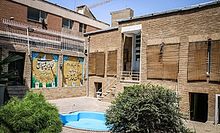Mohammad-Ali Rajai (Persian: محمدعلی رجایی; 15 June 1933 – 30 August 1981) was an Iranian politician who served as the second president of Iran from 2 August 1981 until his assassination four weeks later. Before his presidency, Rajai had served as prime minister under Abolhassan Banisadr, while concurrently occupying the position of foreign affairs minister from 11 March 1981 to 15 August 1981. He died in a bombing on 30 August 1981 along with then-prime minister Mohammad-Javad Bahonar.
Early life and education

Mohammad-Ali Rajai was born on 15 June 1933 in Qazvin, Iran.[1] His father, a shopkeeper named Abdolsamad, died when he was four years old.[2][3] Rajai grew up in Qazvin and moved to Tehran in the late 1940s. He joined the Air Force at age sixteen or seventeen.[4][5] In 1959, he graduated from Tarbiat Moallem University with a degree in education, later working as a teacher of mathematics.[3][5]
Political career
After moving to Tehran, Rajai became involved in the anti-Shah movement and associated with Mahmoud Taleghani and the Fadayeen-e Islam group.[3] A one-time member of the largely anti-clerical People's Mujahedin of Iran (MEK), Rajai soon came out against its left-leaning ideals[6] and in 1960, joined the Freedom Movement of Iran.[1][4] He was arrested at least twice by SAVAK for his opposition activities, with his longest detention lasting from May 1974 to late 1978.[2][4][5] In a 1980 speech to the United Nations Security Council, Rajai displayed his beaten right foot to the audience, attributing its condition to being tortured by the Shah's interrogators in prison.[2][5]


Following the Iranian Revolution in 1979, Rajai left the Freedom Movement and was appointed the minister of education in an Interim Government led by Mehdi Bazargan.[1] Using his newfound power, Rajai sought the rapid Islamization of Iranian schools by banning the teaching of English, removing courses thought to be ''non-Islamic,'' closing universities to prevent potential student dissent, and firing teachers with whom he disagreed.[2][5]
Although Bazargan's cabinet resigned on 6 November 1979 as a result of the Iran hostage crisis, Rajai remained in his post until 12 August 1980, when he was appointed prime minister by newly-elected president Abolhassan Banisadr, who was under pressure from the dominant Islamic Republican Party.[2] Rajai set up his cabinet by selecting Karim Khodapanahi as foreign affairs minister, Mohammad-Reza Mahdavi Kani as interior minister, and Javad Fakoori as defense minister. Just a month into Rajai's premiership on 22 September 1980, the Iran–Iraq War began.
Presidency
Banisadr was impeached on 21 June 1981 by the Iranian Parliament, allegedly because of his moves against the clerics in power. Ruhollah Khomeini, acting as Supreme Leader, held a Provisional Presidential Council of six people headed by Mohammad Beheshti and later Abdolkarim Mousavi Ardebili. Rajai, a member of the Council, nominated himself for the presidential election in 1981, running as a member of the Islamic Republican Party. By winning 91% of the votes, Rajai officially became the president after taking the Oath of Office on 2 August 1981.[7] In one of his first acts in office, he named Mohammad-Javad Bahonar to become the next prime minister of Iran.
Assassination
On 30 August 1981, Rajai held a meeting of Iran's Supreme Defence Council along with Bahonar. Witnesses later stated that a trusted aide brought a briefcase into the conference room, set it between the two leaders, and then left. A short period later, another person opened the case, triggering a hidden bomb that set the room ablaze, leading to the deaths of Rajai, Bahonar, and six other officials.[8] The attack occurred two months after the Haft-e Tir bombing. Iranian officials identified MEK operative Massoud Keshmiri as the culprit, though others allege the bombing was by political rivals within Rajai's political party.[9][10] He is buried in Behesht-e Zahra cemetery.
Political positions
Rajai's political programs were based on a form of constitutional law that included a position of privilege for Islam. He insisted that those in control of the state must be Muslim, emphasized the Velayat-e Faqih, and believed it essential that the government cooperate with institutions such as the Islamic Revolutionary Guard and Islamic Revolutionary Court. He respected people's freedom insofar as it did not contravene Islamic law and tried during his tenure to create a consistent government.[11]
References
- ^ a b c Houchang E. Chehabi (1990). Iranian Politics and Religious Modernism: The Liberation Movement of Iran Under the Shah and Khomeini. I.B.Tauris. p. 87. ISBN 978-1-85043-198-5. Retrieved 27 August 2013.
- ^ a b c d e Brown, Roland Elliott (20 April 2017). "Rajai: The Clerics' Loyalist (1981)". IranWire.
- ^ a b c "Documentary Biography of President Mohammad Ali Rajai". Islamic Revolution International Center. 6 November 2016. Archived from the original on 2 November 2016.
- ^ a b c "Mohammad Ali Raja'i". Encyclopædia Britannica. Retrieved 27 August 2013.
- ^ a b c d e Kihss, Peter (1 September 1981). "Obituaries | Mohammad Ali Rajai, Iran's President". New York Times. Archived from the original on 24 May 2015.
- ^ Ostovar, Afshon P. (2009). "Guardians of the Islamic Revolution Ideology, Politics, and the Development of Military Power in Iran (1979–2009)" (PhD Thesis). University of Michigan. Retrieved 26 July 2013.
- ^ "Rajai Sworn In; Bani-Sadr Predicts Revolt", Pittsburgh Press, 2 August 1981, p. A-8
- ^ Facts on File Yearbook 1981
- ^ Newton, Michael (17 April 2014). Famous Assassinations in World History. ABC-CLIO. p. 27. ISBN 9781610692861. Archived from the original on 4 November 2021. Retrieved 4 November 2020.
- ^ Katzman, Kenneth (2001). "Iran: The People's Mojahedin Organization of Iran". In Benliot, Albert V. (ed.). Iran: Outlaw, Outcast, Or Normal Country?. Nova. p. 101. ISBN 978-1-56072-954-9.
- ^ Ali Ahmadi (1384). "How created a consistent government". Gozaresh. pp. 14–18.
External links
 Media related to Mohammad-Ali Rajai at Wikimedia Commons
Media related to Mohammad-Ali Rajai at Wikimedia Commons


Recent Comments